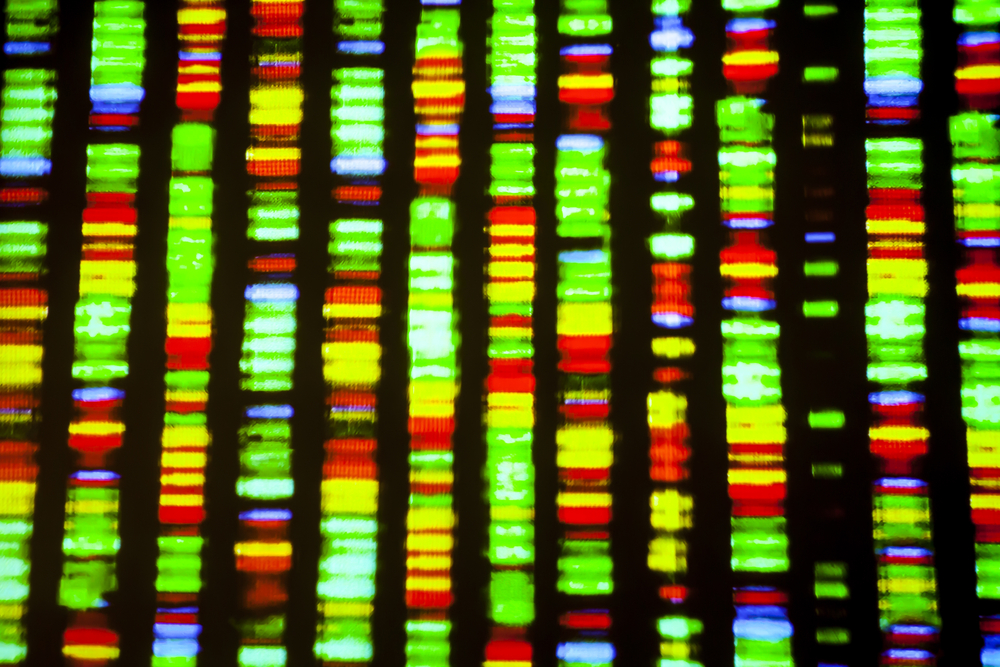The geneticist took a deep breath and sighed. Christoph Nabholz then paused for a moment, considering the complex issues confronting insurers in the age of genomics.
Adverse selection. Sensitive privacy rights concerns. The recent explosion in genetic testing. He chose his words carefully, addressing the delicate subject threatening the industry in measured language.
As many genetic tests were taken last year as in the previous decade, the Swiss Re expert said. And many of the consumers receiving bad news likely bought insurance products to offset their risk.
“It’s a huge boom in testing, and clearly insurance will be affected,” said Nabholz, the reinsurer’s head of research and development, life and health, in a phone interview from Switzerland. “It’s a reality.
“It’s really becoming a concern for the industry, at least in the U.S.”
Genomics is transforming medicine—and slowly but inevitably reshaping insurance.
The rapidly advancing science is forcing the industry to navigate a multitude of actuarial, ethical, privacy and even reputational concerns.
The fundamental business models for life, disability, critical illness and long-term care insurers could be at stake given the growing existential threat of asymmetry of information as more people buy insurance without disclosing their predisposition to certain diseases.
But genomics also offers the chance to better understand risk, reduce claims, engage customers and help them live healthier and longer lives.
“Genomics is both a threat and an opportunity,” said Ari Chester, a partner with McKinsey and Company. “There is a challenge in the medium term with asymmetry of information, but in the long term, that will resolve itself.
“And I believe the industry will be innovative. They will embrace genomics as an opportunity to acquire insight, engage with customers and possibly as a way to improve their customers’ health profiles. It’s a very exciting space.”
The crux of the issue lies in insurers’ need for equal access to deeply personal genetic data to effectively underwrite and price coverage. It intersects consumers’ right to privacy and fear of discrimination with the industry’s need to manage the risk it assumes.
“It’s a very sensitive and potentially emotional issue,” said Dr. Dave Rengachary, senior vice president and chief medical director, U.S. mortality markets for Reinsurance Group of America.
And it’s a wide-ranging issue.
“There are privacy concerns. Reputational concerns. Regulatory concerns,” Chester said. “It requires a long-term view because genomics and the real insight it provides about your health is in its infancy.”
Genomics just may become the greatest disruptor to the life, disability, critical illness and long-term care industries, the equivalent to global warming or cybersecurity risks in the property/casualty space.
The sequencing of the human genome, genetic testing and genome editing are driving innovation in the early detection, treatment and even prevention of asymptomatic disease through personalized or precision medicine.
They will influence everything from how insurance is underwritten and priced to how products are designed.
But insurers are moving cautiously. The science is relatively immature. The regulatory landscape remains uncertain, with at least one state having proposed a ban on using genetic information to underwrite life policies.
And insurers are all too aware of the sticky privacy, data ownership and media coverage concerns that would follow the rejection of applicants due to gene mutations or variants. So they almost uniformly don’t ask applicants to undergo testing for underwriting purposes and rarely seek existing information.
“Right now genetics is not a material insight in the underwriting process, so it’s not asked for,” McKinsey’s Chester said. “If it happens to be in an electronic health record or in a physician’s statement, and if the underwriter happens to request it—which they often do when they’re underwriting for high face value policies—then they will certainly be aware of it.”
However, maintaining access to applicants’ existing genetic data—especially clinical test results—is crucial, experts say. The threat of nondisclosure regulation casts an alarming shadow over the industry.
That is why many have called for uniform oversight and ethical guidelines, preferably in the form of self-regulation.
“Genomics is here,” said Mariana Gomez-Vock, assistant general counsel for the American Council of Life Insurers. “It is an essential issue for the life insurance industry because of the vital role medical information plays in underwriting many policies.
“We need to be able to evaluate the potential effect of that information on the mortality or morbidity risk. There must be a level playing field between the applicant and the insurer.”
Only a Matter of Time
The secrets were once buried deep, hidden in the paired strands of DNA every person carries. The mysteries of the genome—an individual’s complete set of DNA—remained shrouded in 1990, when the Human Genome Project began.
A watershed moment came in 2003 when the international research project completed its mission, sequencing the genome. Decoding the blueprint for every human being—which directs their development and influences their health—has provided revolutionary insight ever since.
“We just want to make sure we don’t lose the right to get this information. That’s the key for us,” Nabholz said.
That is why the significant spike last year in genetic testing—two-thirds of which were clinical tests ordered by doctors and the rest direct-to-consumer tests from companies like 23andMe—are such a concern, according to Nabholz.
For instance, 23andMe offers risk reports for at least 11 diseases, providing the public with revealing genetic information. Those who know they’re predisposed to serious illness could buy excessive and underpriced coverage. And those who test negative could delay insurance purchases or allow their policies to lapse.
More than 12 million people have taken direct-to-consumer DNA tests, with almost 8 million of those tests occurring since 2016. Recent studies indicate as much as 15% of the U.S. population has taken a genetic test, according to Nabholz.
“People who get a genetic test back that is unfavorable, of course they’re going to seek to protect themselves and their family,” he said. “That’s a natural reaction.
“If people take out insurance—which we know they will—it’s only a matter of time before we’ll see the results.”
It’s already happening.
Research by Harvard geneticist Dr. Robert Green found those who know they possess the gene variant associated with increased risk of Alzheimer’s disease are nearly six times more likely to buy long-term care insurance than those who do not.
Antiselection threatens the integrity of risk pools and could inflate rates beyond the reach of applicants.
“It is crucial we maintain access, with applicants’ consent, to vital medical records and other pertinent information of importance in the underwriting process,” Gomez-Vock said.
Life insurers have not been overly concerned given the relatively small segment of the population that has been tested. But that seems to be rapidly changing as testing becomes more accessible, affordable (from $200 to $1,500) and produces quick results.
Dr. John W. Rowe, professor of health policy and aging at the Columbia University Mailman School of Public Health, said insurers have not expressed much concern over antiselection. But that very well could change as genomics matures.
“The basis for concern is more on the part of insurance companies than it is on the individual,” said Rowe, the CEO of Mount Sinai NYU Health from 1998 to 2000 and of Aetna from 2000 to 2006. “I don’t think this is a privacy rights issue so far.
“There is evidence of lots of people signing up for benefits after they get information saying they’re at risk. There is no protection for the insurance companies. And we have not seen—to my knowledge—any movement on the part of the insurance companies to protect themselves.”
Insurers Take Notice of Direct-to-Consumer Genetic Testing
Genetic testing has gone direct to consumer.
Companies such as 23andMe and Color have branched out beyond ancestry, sequencing parts of consumers’ genomes searching for predisposition to a range of disease.
In 2015, the Food and Drug Administration allowed 23andMe to inform customers if they possessed certain disease-carrying gene mutations that could be passed to their children. Then last year, it approved the company to sell genetic tests for disease risk directly to consumers for the first time.
“We have to take notice of the increase in patient-directed tests from 23andMe and other vendors,” said Mariana Gomez-Vock, assistant general counsel for the American Council of Life Insurers.
Over-the-counter testing is often less comprehensive than clinical tests and can be inaccurate. But the overall global market (including ancestry tests) reached $99 million in 2017, according to research firm Kalorama Information.
It projects that market will grow to $310 million by 2022, while a report from Credence Research estimates it will reach $340 million by then.
More than 5 million people worldwide have purchased 23andMe genetic services. The company says it does not share test results with third parties without permission and that information is not included in medical records.
As of April, 23andMe is the only company the FDA has authorized to sell over-the-counter genetic health risk kits without a prescription. It tests for at least 11 diseases.
Color tests for certain types of cancer as well as hereditary heart disease. But it requires a physician’s approval.
There is profound interest in genetic testing.
Sixty-five percent of U.S. employees would be interested in employer-sponsored, affordable access to genetic testing for health reasons if only they and their doctors viewed the results, according to a 2017 Wamberg Genomic Consumer Survey.
However, the clinical value of direct-to-consumer tests is debatable, experts say.
“Direct-to-consumer testing, while certainly getting better in quality, is fairly different from a scientific basis than clinical testing,” said Dr. Daniel Zimmerman, senior vice president and chief medical director GST for Reinsurance Group of America.
“The predictive value of some of those is marginal in that it may show that you have a little bit of an increased risk of developing Disease X. Having spoken with various experts in the field, while these are of interest to many people and have some value, in the big scheme of overall risk prediction, they may not carry that much weight.”
And there is at least one concern, experts say. Consumers can be overwhelmed by genetic test results because they may not completely understand them.
“In medicine, we talk about the case of the incidental gene-oma: A patient who shows up in the office with a 23andMe report, drops it on the doctor’s desk and says, ‘I think I have cancer, and I haven’t slept a wink in the last two weeks,’” said Dr. John W. Rowe, professor of health policy and aging at the Columbia University Mailman School of Public Health. “And they’re completely misinterpreting the test and demanding all kinds of tests like CAT scans and MRIs, which are all expensive and unnecessary.”
Despite the threat, it is essential that insurers handle the issue properly the first time or face serious reputational damage, according to Dr. Daniel Zimmerman, senior vice president and chief medical director global support team for Reinsurance Group of America.
“You have to get this right,” he said. “You can’t mess this up because the public and consumers will remember that. When you breach a responsibility, you lose trust.
“In any situation in life, once you lose trust, it’s extremely difficult to earn it back.”
A Wide Spectrum
But the regulatory landscape remains unsettled.
A federal law passed in 2008 prevents health insurers from seeking the results of genetic testing. However, life, disability, critical illness and long-term care insurers are not bound by the Genetic Information Nondiscrimination Act (GINA).
So state regulators provide oversight on genomics, as they do with most insurance issues.
Every state allows life insurers to consider existing genetic test results in underwriting. That information often is found in patient health records.
But that access has been threatened in at least one state.
The Florida Legislature introduced a bill in December 2017 that would have prohibited the use of any genetic information in evaluating life and long-term care underwriting. The bill was withdrawn in March after meeting stiff resistance.
“It represented an unprecedented assault on the independence of a business to operate wisely and in the interest of present and future policyholders,” Gomez-Vock said.
Eight states already prohibit the use of genetic test results or information in underwriting long-term care insurance, and four states bar its use in disability income insurance.
Massachusetts and Vermont block life insurers from requiring genetic testing. Six states prohibit testing for long-term care insurance, and three states have prohibitions for disability income insurance.
Some insurers such as Northwestern Mutual do request existing genetic information.
“We do not require genetic testing, but we ask applicants to share all information about their medical history, in accordance with state laws,” spokesperson Betsy Hoylman said in a statement. “It’s important during the underwriting process that applicants share all medically relevant information with us to ensure we can offer a policy at the best possible price.”
A wide regulatory spectrum exists in Europe and beyond.
Austria, France and Portugal prohibit the use of genetic data for insurance purposes. Germany and Switzerland allow previously conducted genetic tests to be considered in the risk evaluation of high-value life policies.
In England, insurers have agreed to a moratorium on using predictive genetic information except for life policies worth more than £500,000 (close to $700,000). In India and Japan, insurers also self-regulate.
“There’s a general agreement around the globe that insurers shouldn’t be sending people for genetic tests for underwriting purposes,” Nabholz said. “But once you have test results, unless prohibited by law, the insurance company should be able to ask for the information.
“For many conditions, data is not there yet. So we are concentrating, if at all, on a few conditions like breast cancer and colon cancer genes, where we actually know what the risk is and what the price would be.”
Time to Act?
But the time is approaching for insurance to evolve with the science, some industry experts say.
Genomics is becoming a routine part of health care. And experts envision most Americans will undergo genetic testing in the next two decades.
Genomics already can warn carriers possessing BRCA1 and BRCA2 genes—associated with higher risk of breast and ovarian cancer in women and prostate cancer in men—and ApoE4, a genetic risk factor for Alzheimer’s disease.
And it holds promise for targeted therapy to treat and even prevent inherited disorders such as heart disease, cancer and cystic fibrosis.
After all, insurers want their customers alive and well. It’s not just altruism. It’s good business.
The industry’s long-term interests are served when it has wide adoption and large pools of applicants.
Early detection and intervention increase the odds of customers living long and healthy lives. That means people paying premiums longer as well as reduced or even eliminated medical costs for insurers.
And genomics could lead to new products such as gene therapy coverage.
Life insurers are seeing a steadily increasing amount of genetic information, ACLI’s Gomez-Vock said. Although there is very little predictive testing currently, that will change, she added.
And without equal access to that data, premiums could soar.
Meanwhile, waiting too long to act could allow insurtech startups to disrupt the space.
“As the genetics industry matures, it has the potential to upend the traditional insurance world,” said Caribou Honig, a venture capitalist in the insurtech space.
But the ultimate direction for insurers will be to embrace genomics, with the potential to improve policyholders’ well-being and their underwriting, RGA’s Rengachary said.
“Many years from now, we will look back and see this as an excellent vehicle for the insurer and the consumer to engage in a way that life insurers have been slow to in the past,” he added.
McKinsey’s Chester agrees.
“In the long term, the very innovative life insurance companies might not only request genetic testing but proactively offer it,” he said. “They might say, ‘We’re going to give you insights into your health and let you act on them, but we’re not going to let it influence the underwriting process or cancel your policy if anything shows up.’
“That way they are embracing genomics as a channel to create engagement and support health.”
Some already are.
Last year, MassMutual began offering genome sequencing to customers at a reduced price of $1,400 (instead of $2,500) through an agreement with Human Longevity Inc.
The deal was believed to be the first involving a U.S. life insurer. MassMutual declined an interview request.
Of course, life insurance is a voluntary product. Applicants have the option to grant insurers access to their medical information if they want coverage.
Insurers also acknowledge that predictive tests reveal only that applicants are more likely to develop an illness. Disease is not inevitable for those who carry genetic risk factors. Environment, lifestyle (diet and exercise) and family history play large roles.
In fact, the U.S. government seeks to build a 1 million-strong database of diverse volunteers to compare their genetics, lifestyles and environments. The $1.45 billion, decade-long project, which opened enrollment in May, will explore why some people avoid illness despite carrying increased genetic risk and how to prevent and treat disease.
“You cannot solely look at the genetic test result alone,” RGA’s Zimmerman said. “You put it in the context of the individual. Are they undertaking measures to mitigate what genetic tests may have found?
“It has to be in the holistic picture of the person.”
And insurers have to alleviate fears that they will broadly deny coverage or make it unaffordable.
“It’s important to go above and beyond even what the regulations allow,” Zimmerman said. “There’s a responsibility that insurers have.”




